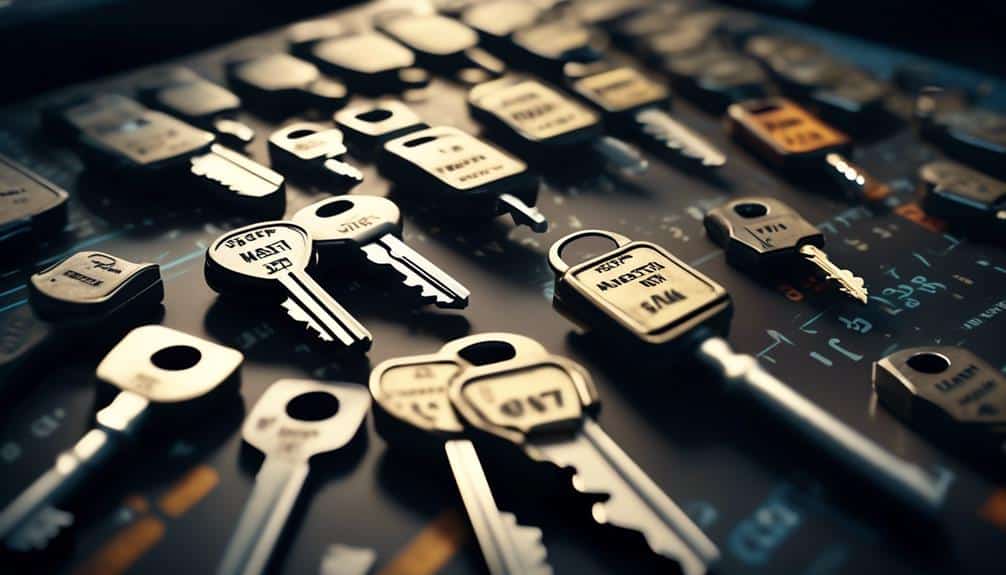They say that 'security is only as strong as its weakest link.' When it comes to airport master key systems, ensuring maximum security is of utmost importance.
As professionals in the field, we understand the critical role these systems play in safeguarding airports and the people who pass through them.
In this discussion, we will explore thirteen practical tips to enhance the security of airport master key systems. By implementing these measures, we can minimize vulnerabilities and stay one step ahead of potential threats.
So, let's uncover these tips that will strengthen the foundation of security and protect the integrity of our airports.
Key Control Measures
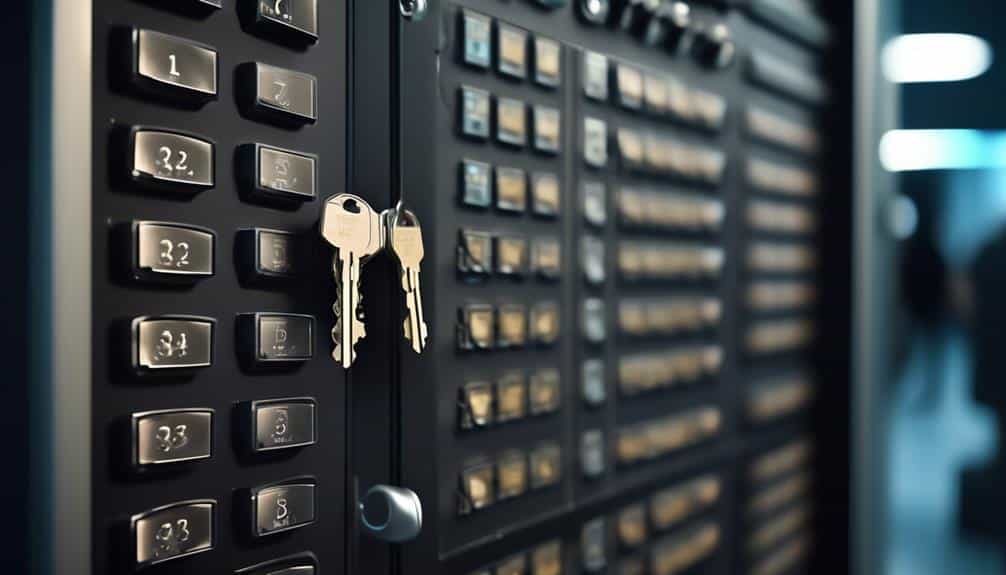
To ensure optimal security, implementing key control measures is imperative at airports. Key control software and key control policies play a vital role in maintaining the security of airport master key systems.
Key control software provides a centralized platform for managing and tracking keys throughout the airport facility. This software enables authorized personnel to assign and track keys, ensuring that only authorized individuals have access to specific areas. With real-time monitoring and reporting capabilities, key control software enhances accountability and minimizes the risk of unauthorized access.
In addition to key control software, key control policies are essential in establishing clear guidelines for key management. These policies outline procedures for key issuance, return, and reporting lost or stolen keys. They also define who's access to specific keys and under what circumstances. By enforcing these policies, airports can ensure that keys are properly controlled and minimize the risk of unauthorized entry or loss.
Restricted Access Areas
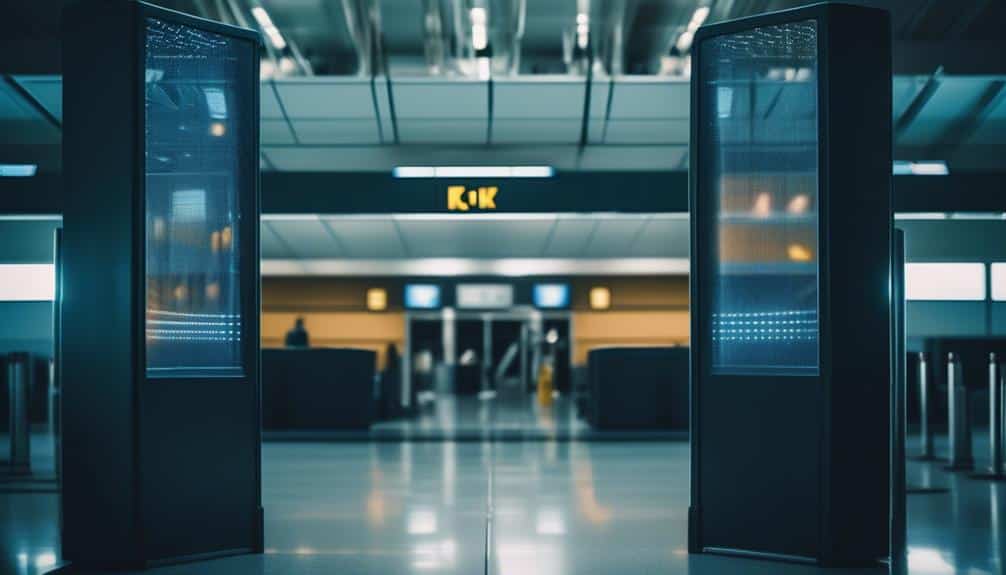
When it comes to airport security, ensuring the safety of restricted access areas is of utmost importance. These areas house sensitive information, valuable assets, and critical infrastructure that must be protected at all costs.
To achieve this, airports employ various access control measures such as biometric scanners, surveillance cameras, and restricted key systems to limit entry to authorized personnel only.
Secure Restricted Areas
Secure restricted areas in airport master key systems are essential for maintaining the overall security and integrity of the facility. These areas are designed to provide secure access to authorized personnel while preventing unauthorized individuals from entering. Implementing stringent security protocols is crucial to ensure that only authorized personnel can access these areas.
To achieve secure restricted areas, airport master key systems should utilize advanced access control technologies, such as biometric authentication and smart cards. These technologies enhance the overall security of the system by providing an additional layer of verification and reducing the risk of unauthorized access.
Additionally, regular audits and inspections should be conducted to identify any vulnerabilities or breaches in the system. This proactive approach allows for timely detection and resolution of security issues, ensuring that the restricted areas remain secure at all times.
Access Control Measures
Implementing robust access control measures is crucial for ensuring the security of restricted areas in airport master key systems. To effectively control access, airports should consider the following:
- Access Control Integration: Integrate the airport's master key system with the access control system to enhance security. This allows for centralized control and monitoring of access to restricted areas.
- Biometric Authentication: Implement biometric authentication methods, such as fingerprint or iris scanning, to ensure only authorized individuals gain entry. Biometrics provide a high level of security as they're unique to each individual.
- Secure Entry Points: Install secure entry points with controlled access mechanisms, such as card readers or biometric scanners. This prevents unauthorized personnel from entering restricted areas.
Key Holder Accountability

To ensure key holder accountability in airport master key systems, it's crucial to track key usage and implement access controls.
By keeping a record of key movements and restricting access to authorized personnel only, airports can minimize the risk of unauthorized access and potential security breaches.
This level of accountability is essential for maintaining the integrity and security of restricted areas within the airport premises.
Tracking Key Usage
We ensure key holder accountability by implementing a comprehensive system to track key usage at all times. To effectively track key usage and maintain a high level of security, we utilize key inventory management methods and key tracking software.
Here's how we do it:
- Electronic key logging: We log each key's activity electronically, recording details such as the time the key was checked out and returned, as well as the name of the key holder.
- Real-time monitoring: Our key tracking software allows us to monitor key usage in real-time, providing us with accurate information about who's access to specific keys at any given moment.
- Auditing and reporting: We regularly conduct audits to ensure that key holders are using their keys responsibly. Our reporting system generates detailed activity reports, allowing us to identify any discrepancies or potential security breaches.
Implementing Access Controls
How can we ensure accountability among key holders through effective access controls?
One way is by implementing biometric authentication systems. These systems use unique physical or behavioral characteristics, such as fingerprints or retinal scans, to verify the identity of key holders. By linking these biometric data to access control systems, we can ensure that only authorized individuals can gain entry.
Additionally, implementing visitor management systems can enhance key holder accountability. These systems can track and monitor the movement of visitors within the airport, providing valuable information on who accessed certain areas and when.
Regular Key Audits

Regular key audits are an essential security measure for maintaining the integrity of airport master key systems. By conducting regular key audits, airports can ensure that their keys are accounted for and secure at all times. Here are three reasons why regular key audits are crucial for airport security:
- Identify Missing or Unauthorized Keys: Regular key audits allow airports to identify any missing or unauthorized keys. By comparing the audit results with the master key inventory, any discrepancies can be immediately addressed. This helps prevent unauthorized access and potential security breaches.
- Track Key Usage: Key audits provide valuable information on key usage patterns. By examining the audit data, airports can identify any irregularities or suspicious activities, such as excessive key usage or multiple access attempts. This information can help in detecting potential security threats and taking appropriate action.
- Maintain Secure Key Storage Solutions: Key audits also ensure that secure key storage solutions are being properly utilized. By verifying that keys are stored in designated secure areas, airports can minimize the risk of theft or unauthorized access. Regular audits can identify any issues with key storage practices and allow for corrective measures to be implemented.
Key Issuance Protocols
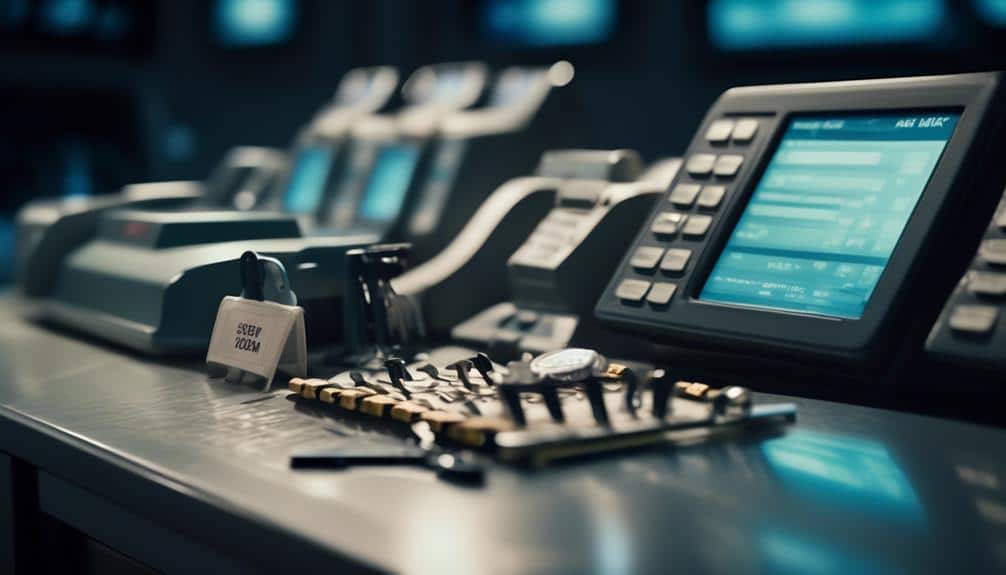
When it comes to key issuance protocols, efficiency is paramount. We need to ensure that keys are distributed in a timely and organized manner, minimizing any potential delays or disruptions in airport operations.
Additionally, implementing strict access control measures will help to prevent unauthorized individuals from obtaining keys.
Lastly, it's crucial that any lost or stolen keys are promptly reported and replaced to maintain the integrity of the key system.
Efficient Key Distribution
To ensure efficient key distribution in airport master key systems, it's essential to establish and follow key issuance protocols. These protocols help to streamline the process and maintain the security of the system. Here are three key elements to consider:
- Centralized Key Management: Implementing a centralized system allows for efficient key tracking and reduces the risk of unauthorized duplication or loss. This ensures that keys are easily accessible when needed and that their usage can be monitored effectively.
- Strict Access Control: Limiting access to key issuance areas through secure access control measures, such as key card systems or biometric authentication, enhances security and prevents unauthorized individuals from obtaining keys.
- Documentation and Auditing: Keeping accurate records of key distribution and usage is crucial for accountability. Regular audits should be conducted to identify any discrepancies or potential security breaches and address them promptly.
Access Control Measures
Implementing access control measures is crucial in ensuring the security and efficiency of key issuance protocols in airport master key systems.
Access control systems play a vital role in regulating the distribution of keys and preventing unauthorized access to restricted areas.
One effective measure is the use of biometric authentication, which enhances security by verifying an individual's unique physical or behavioral characteristics. Biometric authentication methods such as fingerprint or iris scanning provide a high level of accuracy and reliability in confirming an individual's identity.
These systems can be integrated into the key issuance process, requiring employees to authenticate themselves before receiving a key.
Reporting Lost or Stolen Keys
One important aspect of key issuance protocols in airport master key systems is the prompt reporting of lost or stolen keys. To ensure the security of the airport, it's crucial to have efficient reporting procedures in place.
Here are three key steps to follow when dealing with lost or stolen keys:
- Notify the appropriate authority immediately: As soon as a key is lost or stolen, it's essential to report it to the designated authority, such as the airport security office or the key control department. This prompt notification allows for quick action to be taken to mitigate any potential security risks.
- Document the incident: It's important to keep a record of the lost or stolen key, including the date, time, and location. This documentation helps in tracking the key and identifying any patterns of unauthorized access.
- Initiate the key replacement process: Once the incident is reported, the key replacement process should be initiated promptly. This involves deactivating the lost or stolen key and issuing a new one to the authorized personnel.
Secure Key Storage Solutions

For secure key storage solutions, it's essential to utilize a robust and reliable system. Key storage solutions play a crucial role in maintaining the security and integrity of an airport's master key system. One such solution is the implementation of key management software.
Key storage solutions provide a secure and organized way to store and manage keys. They ensure that only authorized personnel have access to the keys, minimizing the risk of unauthorized entry or key duplication. With a robust key storage system, airports can effectively control and track the movement of keys, reducing the chances of theft or loss.
Key management software is an integral part of secure key storage solutions. It allows for centralized control and monitoring of the key system. Authorized personnel can easily track key usage, generate reports, and manage access permissions. This software provides an added layer of security by ensuring that keys are only accessed by authorized individuals.
To ensure the effectiveness of key storage solutions, it's essential to choose a system that meets the specific needs and requirements of the airport. Factors such as the number of keys, the level of security required, and the ease of use should be considered when selecting a key storage solution.
Key Management Software

Key management software is an essential component of a secure key storage solution, providing centralized control and monitoring of the key system. With the increasing complexity of airport master key systems, it's crucial to implement efficient key management solutions to ensure the highest level of security.
Key tracking software offers several benefits that enhance the overall security of an airport's key system:
- Centralized Control: Key management software allows for centralized control over the entire key system, enabling administrators to monitor access, track key usage, and quickly respond to any security breaches or unauthorized activities.
- Real-Time Monitoring: This software provides real-time monitoring of key movements, including check-outs, returns, and transfers. It generates detailed reports and audit trails, allowing administrators to identify any inconsistencies or suspicious activities promptly.
- Automated Notifications: Key tracking software sends automated notifications to designated personnel when keys are overdue, ensuring timely follow-up and preventing potential security risks.
Employee Training and Awareness
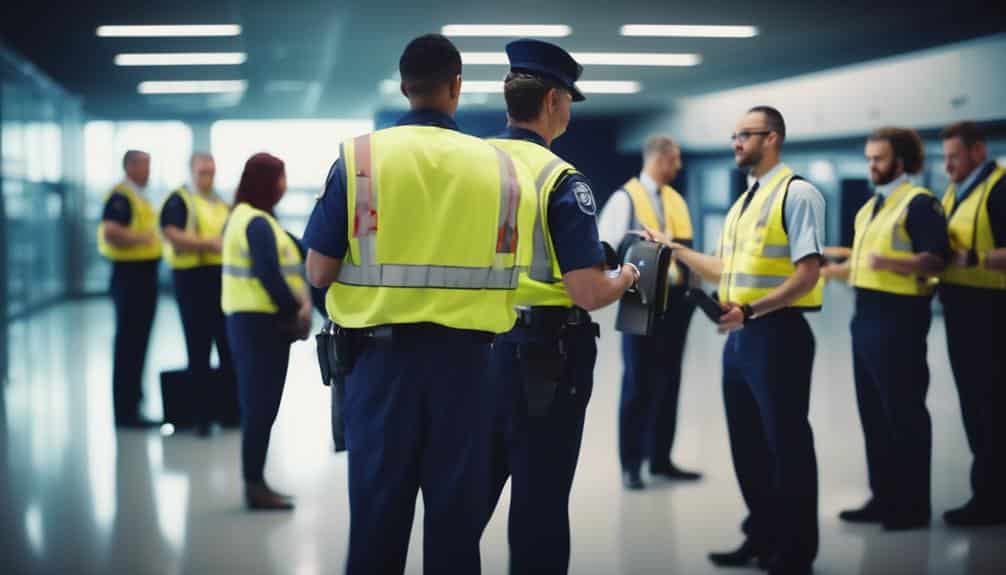
Employee training plays a crucial role in ensuring the effectiveness of security protocols at airports. To maximize security, it's essential to provide comprehensive training programs that cover a range of topics.
First and foremost, employees must be educated on the importance of security protocols and the potential consequences of failing to comply with them. They should understand the specific security measures in place at the airport and the role they play in maintaining a safe environment.
Training should also include instruction on how to identify and respond to potential security threats, such as suspicious behavior or unauthorized access attempts. Additionally, employees should be trained on the proper use and handling of security equipment, such as X-ray machines and metal detectors.
Regular refresher courses and ongoing awareness campaigns are also essential to reinforce the importance of security protocols and keep employees up-to-date with any changes or updates.
Key Replacement Procedures

After ensuring employees are trained and aware of the essential elements of airport security, it's crucial to establish clear and efficient key replacement procedures. These procedures are vital for maintaining the integrity of the airport master key system and preventing unauthorized access.
To achieve this, the following key replacement protocols should be implemented:
- Documentation: Maintain a detailed record of all key replacements, including the date, reason for replacement, and the person responsible for issuing the new key. This documentation ensures accountability and transparency in the key replacement process.
- Authorized Personnel: Only authorized personnel should be allowed to replace keys. This minimizes the risk of unauthorized individuals obtaining access to sensitive areas.
- Secure Storage: Store replacement keys in a secure location, such as a locked cabinet or safe, accessible only to authorized personnel. This prevents unauthorized access to replacement keys and reduces the likelihood of theft or loss.
Emergency Key Access Protocols
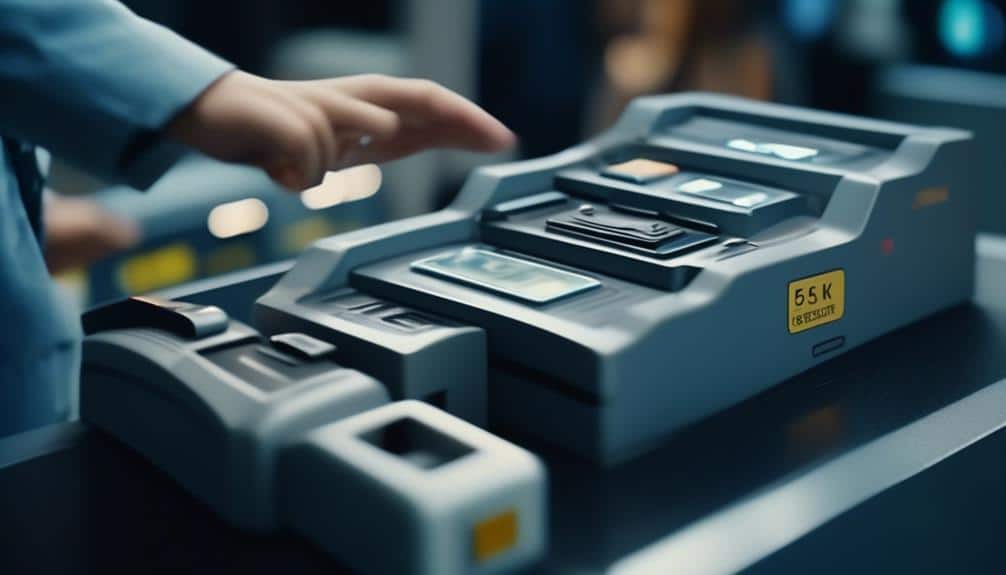
To ensure immediate and secure access during emergency situations, it is imperative to establish efficient protocols for emergency key access. The proper storage and retrieval of emergency keys is crucial for maintaining the safety and security of airport facilities.
One way to ensure effective emergency key access is to implement a comprehensive emergency key storage system. This system should include a secure location for storing emergency keys, such as a locked cabinet or safe. Access to this storage area should be restricted to authorized personnel only, and a log should be maintained to track when keys are accessed and by whom.
In addition to a secure storage system, it is important to establish clear protocols for the retrieval of emergency keys. These protocols should outline the steps that need to be followed in the event of an emergency, including who is responsible for retrieving the keys and the process for obtaining them. It is also essential to regularly update and test these protocols to ensure their effectiveness.
By implementing efficient emergency key access protocols, airports can enhance their security measures and ensure that authorized personnel have immediate access to necessary keys during emergency situations. The table below provides an overview of the key components of an effective emergency key access protocol.
| Component | Description |
|---|---|
| Secure Storage | Utilize a locked cabinet or safe to store emergency keys |
| Restricted Access | Limit access to authorized personnel only |
| Logging | Maintain a log to track key access and usage |
| Retrieval Process | Establish clear protocols for retrieving keys during emergencies |
| Regular Updates | Update and test protocols regularly to ensure effectiveness |
Periodic Key System Upgrades

Periodic upgrades to the airport's key system are essential to maintaining optimal security and efficiency. As part of our commitment to periodic system maintenance, we recommend the following key system upgrades:
- Advanced Key Technology: Upgrading to advanced key technology, such as electronic or biometric systems, can enhance security measures. These systems provide better control over key access, allowing for greater accountability and reducing the risk of unauthorized entry.
- Key Tracking Software: Implementing key tracking software allows for real-time monitoring of key usage and enhances overall system management. This software provides valuable insights into key usage patterns, allowing for better resource allocation and identification of potential security vulnerabilities.
- Enhanced Key Duplication Controls: Upgrading key duplication controls ensures that only authorized personnel can request key copies. Implementing systems that require proper authorization and documentation helps prevent unauthorized key duplication and reduces the risk of key misuse.
Collaboration With Security Agencies

As we continue to enhance the airport's key system, an important aspect to consider is the collaboration with security agencies, ensuring a comprehensive approach to safeguarding the airport's premises and resources. Collaboration strategies and information sharing are crucial in maintaining a strong security posture.
Effective collaboration with security agencies involves establishing open lines of communication and fostering a spirit of cooperation. Regular meetings and discussions should be conducted to exchange information, identify potential vulnerabilities, and address any emerging threats. By sharing intelligence and insights, we can collectively stay ahead of evolving security risks.
One key collaboration strategy is the establishment of joint task forces or working groups. These groups bring together representatives from different security agencies, including local law enforcement, federal agencies, and airport security personnel. By working together, these agencies can pool their expertise and resources to tackle security challenges more effectively.
Another important aspect of collaboration is the sharing of information. This includes sharing intelligence on potential threats, best practices in security protocols, and lessons learned from past incidents. By sharing information, we can enhance our collective understanding of security risks and develop more robust countermeasures.
Ongoing System Monitoring and Evaluation
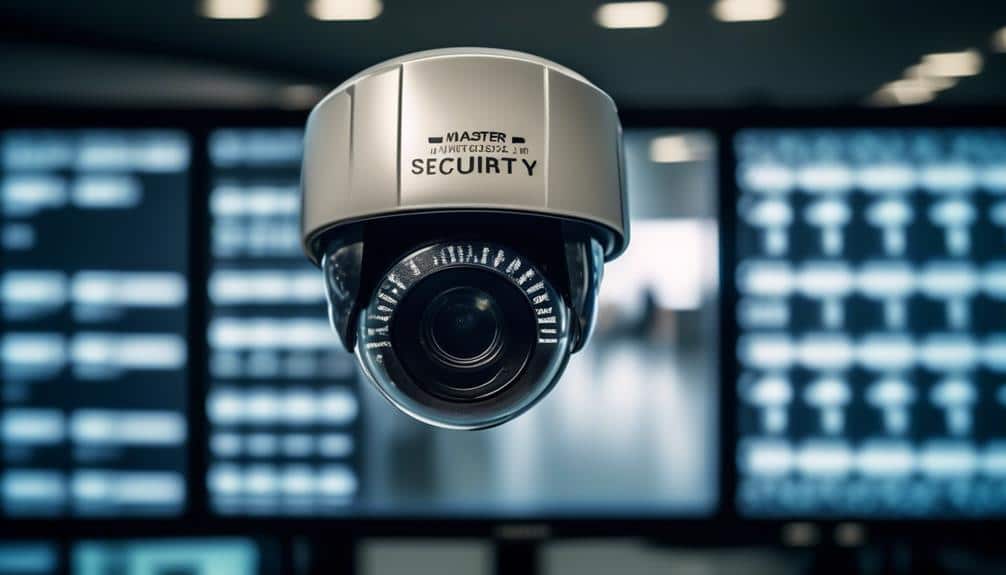
We continuously monitor and evaluate the airport's key system to ensure its ongoing effectiveness and security. This ongoing system evaluation is crucial in preventing security breaches and maintaining the overall integrity of the airport's key system.
Here are three key aspects of our ongoing system monitoring and evaluation:
- Regular Audits: We conduct regular audits of the airport's key system to identify any potential vulnerabilities or weaknesses. These audits involve a comprehensive review of the system's configuration, access logs, and key issuance records. By conducting regular audits, we can proactively address any security concerns and make necessary adjustments to enhance the system's effectiveness.
- Incident Response: In the event of a security incident or breach, we have a well-defined incident response plan in place. This plan includes protocols for identifying and containing the breach, as well as procedures for restoring the system's security. By promptly responding to security incidents, we can minimize the impact and prevent further breaches.
- Performance Monitoring: We continuously monitor the performance of the airport's key system to ensure that it meets the required security standards. This includes monitoring system logs, analyzing access patterns, and conducting regular performance tests. By monitoring the system's performance, we can identify any potential issues or anomalies and take appropriate actions to maintain the system's security.
Through ongoing system monitoring and evaluation, we strive to prevent security breaches and ensure the ongoing effectiveness of the airport's key system.
Frequently Asked Questions
What Are the Common Challenges Faced in Implementing Key Control Measures at Airports?
Implementing key control measures at airports can present several challenges. One of the main hurdles is ensuring the security and integrity of the master key system. This is like navigating through a labyrinth, where every turn and decision have significant consequences.
Another challenge is maintaining strict access controls to prevent unauthorized individuals from obtaining or misusing keys. It requires constant vigilance and coordination among various stakeholders to overcome these challenges and ensure the safety and security of airport facilities.
How Often Should Key Audits Be Conducted to Ensure the Security of the Airport Master Key System?
Key audit frequency is crucial for maintaining the security of our airport master key system. Regular audits ensure that all keys are accounted for and in the hands of authorized personnel. They help identify any potential vulnerabilities or breaches in our key management process.
What Are the Consequences for Key Holders Who Fail to Adhere to Key Holder Accountability Protocols?
When it comes to key control challenges, it's crucial to address the consequences for key holders who fail to adhere to accountability protocols. Not only does this compromise the security of the airport master key system, but it also puts the entire airport at risk.
Therefore, it's imperative to have strict penalties in place for those who neglect their responsibilities as key holders. By enforcing accountability measures, we can ensure the highest level of security for our airport.
Are There Any Specific Guidelines or Best Practices for Secure Key Storage Solutions at Airports?
Secure key storage solutions and key management protocols are crucial for maintaining the highest level of security at airports.
By implementing specific guidelines and best practices, airports can ensure that keys are stored securely and accessed only by authorized personnel.
This includes using secure key cabinets or lockers, implementing strict access control measures, and regularly auditing key usage and accountability.
These measures help to minimize the risk of unauthorized access to sensitive areas and enhance overall airport security.
How Frequently Should Employee Training and Awareness Programs Be Conducted to Maintain a High Level of Security in Airport Master Key Systems?
How often should we conduct employee training to ensure a high level of security in airport master key systems?
Maintaining a strong security posture requires regular training and awareness programs. By regularly refreshing employees' knowledge and skills, we can proactively address potential vulnerabilities and reinforce security protocols.
Implementing frequent training sessions allows us to stay ahead of emerging threats and ensure that our staff remains vigilant and well-prepared to handle any security situations that may arise.

